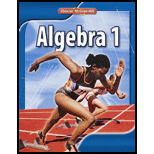
a.
To explain that the expressions for volume and surface area are monomials
a.
Answer to Problem 36SR
Yes, the expressions for volume and surface area are monomials because each is the product of variables and a real number.
Explanation of Solution
Given information:
The side length of the cube is represented as
The volume of the cube is represented as
The surface area of the cube is represented as
Yes, the expression for volume is monomial because this expression is the product of variables. And the expression for surface area is also monomial because it is a non-linear expression since the exponent is a positive number other than 1.
Therefore, both the expression, volume and surface area of cube are monomial because each is the product of variables and a real number.
b.
To calculate the volume and surface area of the cube
b.
Answer to Problem 36SR
The volume of the cube is
Explanation of Solution
Given information:
The side of the cube measures 3 feet
The volume of the cube is calculated as,
The surface area of the cube is calculated as,
Therefore, the volume of the cube is
c.
To calculate the side length
c.
Answer to Problem 36SR
The side length of the cube is
Explanation of Solution
Given information:
The volume and surface area of the cube have the same measure
Calculation:
Since the volume and the surface area of the cube have same measure so its side length is calculated as,
Therefore, the side length of the cube is
d.
To calculate the ratio of volume of two cylinders
d.
Answer to Problem 36SR
The ratio of volume of two cylinders is
Explanation of Solution
Given information:
The volume of the first cylinder is
The volume of the second cylinder is
Calculation:
The ratio of the first and second cylinder can be obtained as,
Therefore, the ratio of volume of two cylinders is
Chapter 12 Solutions
Algebra 1
Additional Math Textbook Solutions
College Algebra with Modeling & Visualization (5th Edition)
A First Course in Probability (10th Edition)
Elementary Statistics (13th Edition)
University Calculus: Early Transcendentals (4th Edition)
Thinking Mathematically (6th Edition)
- Answer this questionarrow_forward1. vector projection. Assume, ER1001 and you know the following: ||||=4, 7=-0.5.7. For each of the following, explicitly compute the value. འབ (a) (b) (c) (d) answer. Explicitly compute ||y7||. Explain your answer. Explicitly compute the cosine similarity of and y. Explain your Explicitly compute (x, y). Explain your answer. Find the projection of onto y and the projection of onto .arrow_forward2. Answer the following questions using vectors u and v. --0-0-0 = find the the cosine similarity and the angle between u and v. འརྒྱ (a) (b) find the scalar projection of u onto v. (c) find the projection of u onto v. (d) (e) (f) find the scalar projection of onto u. find the projection of u onto u. find the projection of u onto and the projection of onto . (Hint: find the inner product and verify the orthogonality)arrow_forward
- Using f(x) = log x, what is the x-intercept of g(x) = log (x + 4)? Explain your reasoning. Please type out answerarrow_forwardThe function f(x) = log x is transformed to produce g(x) = log (x) – 3. Identify the type of transformation and describe the change. Please type out answerarrow_forwardEach graph below is the graph of a system of three linear equations in three unknowns of the form Ax = b. Determine whether each system has a solution and, if it does, the number of free variables. A. O free variables ✓ B. no solution C. no solution D. no solution E. 1 free variable F. 1 free variablearrow_forward
- Solve the following systems of equations and show all work.y = x2 + 3y = x + 5 Please type out answerarrow_forwardSolve the following system of equations. Show all work and solutions.y = 2x2 + 6x + 1y = −4x2 + 1 Please type out answerarrow_forwardDalia buys 20 collectible gems per month. Grace sells 10 gems from her collection of 120 each month. When will Dalia have more gems than Grace? Show your work. Dear Student If You Face any issue let me know i will solve your all doubt. I will provide solution again in more detail systematic and organized way. I would also like my last 3 questions credited to mearrow_forward
 Algebra and Trigonometry (6th Edition)AlgebraISBN:9780134463216Author:Robert F. BlitzerPublisher:PEARSON
Algebra and Trigonometry (6th Edition)AlgebraISBN:9780134463216Author:Robert F. BlitzerPublisher:PEARSON Contemporary Abstract AlgebraAlgebraISBN:9781305657960Author:Joseph GallianPublisher:Cengage Learning
Contemporary Abstract AlgebraAlgebraISBN:9781305657960Author:Joseph GallianPublisher:Cengage Learning Linear Algebra: A Modern IntroductionAlgebraISBN:9781285463247Author:David PoolePublisher:Cengage Learning
Linear Algebra: A Modern IntroductionAlgebraISBN:9781285463247Author:David PoolePublisher:Cengage Learning Algebra And Trigonometry (11th Edition)AlgebraISBN:9780135163078Author:Michael SullivanPublisher:PEARSON
Algebra And Trigonometry (11th Edition)AlgebraISBN:9780135163078Author:Michael SullivanPublisher:PEARSON Introduction to Linear Algebra, Fifth EditionAlgebraISBN:9780980232776Author:Gilbert StrangPublisher:Wellesley-Cambridge Press
Introduction to Linear Algebra, Fifth EditionAlgebraISBN:9780980232776Author:Gilbert StrangPublisher:Wellesley-Cambridge Press College Algebra (Collegiate Math)AlgebraISBN:9780077836344Author:Julie Miller, Donna GerkenPublisher:McGraw-Hill Education
College Algebra (Collegiate Math)AlgebraISBN:9780077836344Author:Julie Miller, Donna GerkenPublisher:McGraw-Hill Education





